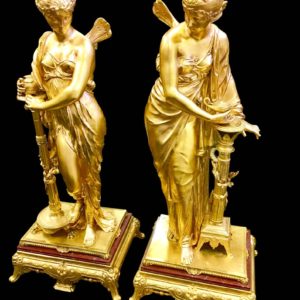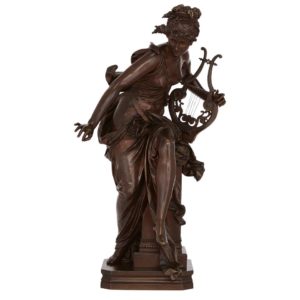描述
Mathurin Moreau (18 November 1822 – 14 February 1912),French sculptor in the academic style 具有學院派創作風格的法國雕塑家。
Mathurin Moreau was a French sculptor born in Dijon in 1822. Mathurin came from a distinguished family of artists, studying initially under his father. His father, Jean-Baptiste Moreau (1797-1855), a sculptor in Dijon, was best known for his restoration of the medieval tombs of the Dukes of Burgundy, which had been damaged during the French Revolution. In 1841, Mathurin entered the Ecole des Beaux-Arts, Paris, where he trained under Etienne-Jules Ramey and Augustin-Alexandre Dumont.
Mathurin Moreau是一位出生於1822年法國Dijon的法國雕塑家。他出生自一個聲譽卓越的藝術家庭,藝術陶冶師承自他的父親Jean-Baptiste Moreau (1797-1855)(也是一位雕塑家,最為知名的創舉在於修復因為法國大革命期間而受損壞的勃根第公爵中世紀陵寢)。在1841年,Mathurin進入巴黎最負盛名的“École des Beaux-Arts”美術學院就讀,並在兩位大師Etienne-Jules Ramey和Augustin-Alexandre Dumont底下學習。
He made his Salon debut in 1848 with Elegy (plaster, Dijon, Mus. B.-A.). In 1852 his Flower Fairy, exhibited at the Salon in plaster, was commissioned by the State in bronze (Dijon, Mus. B.-A.). At the 1861 Salon, his marble Spinner was also bought by the State, for the Musee du Luxembourg, Paris (version, Dijon. Mus. B.-A.).
他在1848年於沙龍舉辦他個人首次個展,主題是Elegy(石膏)。在1852年他的花仙子,在沙龍首展時是用石膏,之後受國家委託訂製而以銅雕形象呈現。在1861年,他的大理石雕作品同樣是由國家所購買,展示於法國巴黎第六區的盧森堡博物館(其中有部分展品於1986年移往奧賽美術館)
Poetic works of this kind continued to earn Moreau medals and prizes at subsequent Salons and international exhibitions. Among his public works, he contributed decorative sculpture to the new Opera and to the rebuilt Hotel de Ville in Paris, and also produced some commemorative statues, such as that in Dijon to Sadi Carnot, President of the French Republic (marble and bronze, 1899; Dijon, Place de la Republique), which he executed in collaboration with Paul Gasq (b 1860; fl 1881-1909).
這種富含詩意且細膩的作品,在他隨後的沙龍創作生涯和國際展覽中,為他贏得多座獎牌和獎盃。在他的公共作品中,他為了新的歌劇院和在巴黎重建的Hotel de Ville創作了極富裝飾性的雕塑作品,同一時期,他也製作了一些紀念雕像,諸如展示於Dijon的Sadi Carnot-法蘭第三共和的第四任總統(大理石和青銅,1899年),這樣作品是他與法國知名雕塑家Paul Gasq(b 1860; fl 1881-1909)共同合作完成。
However, it was probably the extent of his entrepreneurial activities that won for Moreau an influential position in public life. Having provided many sculpture models for commercial exploitation by the Val d’Osne foundry, he became one of the administrators of the Society du Val d’Osne. Together with his pupil and namesake, Auguste Moreau (1834-1917), he continued, well into the 20th century, to supply models for the manufacture of decorative bronze.
然而,應該也是受到這種多元化創作活動的影響,Moreau在公眾事務上獲得極大的影響力,並替Val d’Osne鑄造廠提供了一些銅雕的模型來進行商業性開發活動,他本人最後成為Val d’Osne鑄造廠的共同管理者之一,他和他的學生(同時也是他的兄弟)Auguste Moreau (1834-1917),一同創作了許多深受喜愛且極富裝飾性的銅雕模型。
From 1878 Moreau was mayor of the 19th arrondissement in Paris. The Civil Marriage, a painting by Henri Gervex that hangs in the Salle des Mariages of the Mairie of that arrondissement, shows Moreau officiating at his son’s civil marriage ceremony, before a distinguished audience. In 1912 he had a street named in his honor.
1878年Moreau受任為巴黎第十九區的行政首長。從一幅展示在公證結婚廳由Henri Gervex所繪製的『Civil Marriage』,展示了他在為數眾多的公眾面前,親自以主持行政首長的身分主持了其子的婚禮。在1912年,甚至出現了以他的名字來命名的巴黎街道,足以展現其過人的影響力。以下為展示在巴黎公共空間的Moreau大型藝術品。





